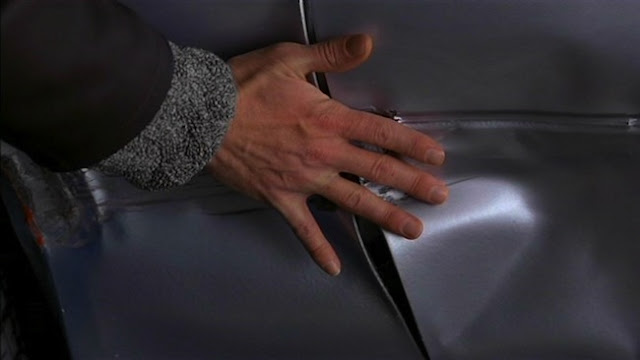Parkitecture 2005: grazing Grant Park
THE SUN STILL SHINES ON THE FIELDHOUSE as the Grant Park Advisory Council convenes "Parkitecture 2005," a slide-and-pony panel on proposed development, including a seventy-two-story high-rise planned for 21-29 South Wabash, with a spire that would cast shadows across downtown and the park.
About sixty attendees fill folding chairs with a view of the park and a rickety projector screen. Bob O'Neill of the Grant Park Conservancy flops a novel-sized black leather organizer to the table. The images, O'Neill confides, play on "the same little portable computer" he'd shown to Mayor Daley. Old snaps of litter and graffiti and unimproved mud are matched by cultivated vistas today, marked by uniform JCDecaux bus shelters. "Mayor Daley has made downtown Chicago irresistible," he enthuses. At first, optimism rules about the future of Chicago's architectural ideals, and "Chicago's front yard, its jewel, its outdoor civic center." A tiny redheaded boy loops the rink outside. Behind the disused YWCA building at 830 South Michigan, O'Neill describes, there'll be "a nice restaurant and a grocery store and a spa.... A nice compromise" on the rules of the historical district. The goal, he says as he starts to introduce the other five architecture players, is to "bring people and activity and property taxes into the city." He reels off the academic and corporate credentials of "our distinctive, distinguished panel." Jack Guthman, a zoning specialist who represents developers from the Shefsky & Froelich firm, typifies the "This is my opinion, I think I'm right" contingent--a statement he later makes--saying with a smile, there's no need to talk about "the appropriateness of skyscrapers." "People don't come to Chicago to look at short buildings. It is a true laboratory. Tall is not a four-letter word!" James Peters, a planner for the Landmark Preservation Council of Illinois, leans into the matter, saying, "I guess I'm supposed to say I hate tall buildings." He sets right to it: that this glass-clad needle would be a dangerous precedent, with a height two-to-three times larger than anything around, "allowing zoning rather than character of a historical district" to define development. Outside, the sky goes to dusk and night birds dip and dart. O'Neill warns, "We want these to be productive meetings," before teasing the first questioner for being a "bird rescuer." John Lahey, president of Solomon Cordwell Buenz & Associates, says that "Good buildings sell better," and that "people want light and air but you can't count on that in an evolving city." O'Neill agrees. "The truth is there is no guarantee to a view." He adopts a mocking approximation of a woman's voice, "'My view from my bathroom's going to be blocked!' Maybe they're constipated, I dunno!'"
An hour and a half has passed. Spring beckons. The boy still skates. The streetlamps light up along the green span, all but one, the one directly behind the panelists' heads.
[Originally published in a slightly different form in Newcity, 3 June 2005]
About sixty attendees fill folding chairs with a view of the park and a rickety projector screen. Bob O'Neill of the Grant Park Conservancy flops a novel-sized black leather organizer to the table. The images, O'Neill confides, play on "the same little portable computer" he'd shown to Mayor Daley. Old snaps of litter and graffiti and unimproved mud are matched by cultivated vistas today, marked by uniform JCDecaux bus shelters. "Mayor Daley has made downtown Chicago irresistible," he enthuses. At first, optimism rules about the future of Chicago's architectural ideals, and "Chicago's front yard, its jewel, its outdoor civic center." A tiny redheaded boy loops the rink outside. Behind the disused YWCA building at 830 South Michigan, O'Neill describes, there'll be "a nice restaurant and a grocery store and a spa.... A nice compromise" on the rules of the historical district. The goal, he says as he starts to introduce the other five architecture players, is to "bring people and activity and property taxes into the city." He reels off the academic and corporate credentials of "our distinctive, distinguished panel." Jack Guthman, a zoning specialist who represents developers from the Shefsky & Froelich firm, typifies the "This is my opinion, I think I'm right" contingent--a statement he later makes--saying with a smile, there's no need to talk about "the appropriateness of skyscrapers." "People don't come to Chicago to look at short buildings. It is a true laboratory. Tall is not a four-letter word!" James Peters, a planner for the Landmark Preservation Council of Illinois, leans into the matter, saying, "I guess I'm supposed to say I hate tall buildings." He sets right to it: that this glass-clad needle would be a dangerous precedent, with a height two-to-three times larger than anything around, "allowing zoning rather than character of a historical district" to define development. Outside, the sky goes to dusk and night birds dip and dart. O'Neill warns, "We want these to be productive meetings," before teasing the first questioner for being a "bird rescuer." John Lahey, president of Solomon Cordwell Buenz & Associates, says that "Good buildings sell better," and that "people want light and air but you can't count on that in an evolving city." O'Neill agrees. "The truth is there is no guarantee to a view." He adopts a mocking approximation of a woman's voice, "'My view from my bathroom's going to be blocked!' Maybe they're constipated, I dunno!'"
An hour and a half has passed. Spring beckons. The boy still skates. The streetlamps light up along the green span, all but one, the one directly behind the panelists' heads.
[Originally published in a slightly different form in Newcity, 3 June 2005]
